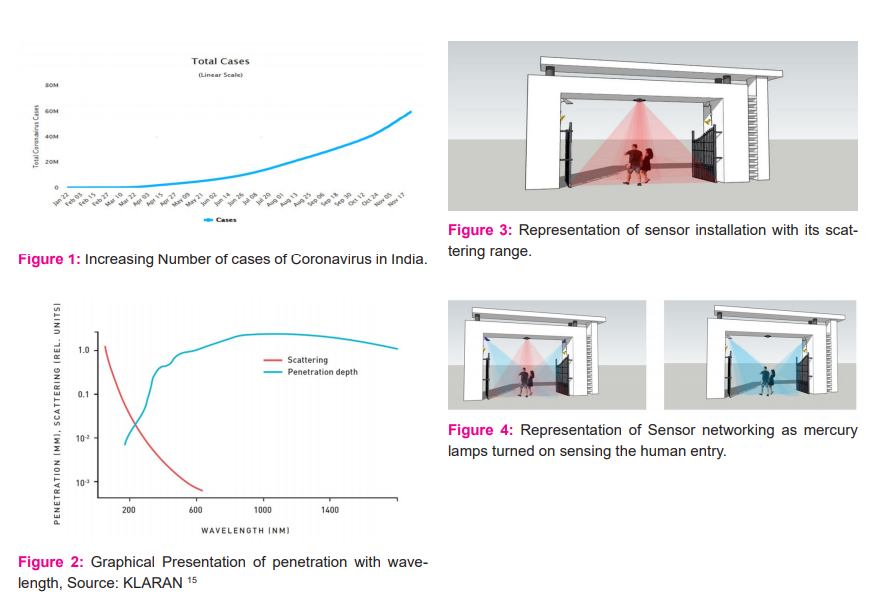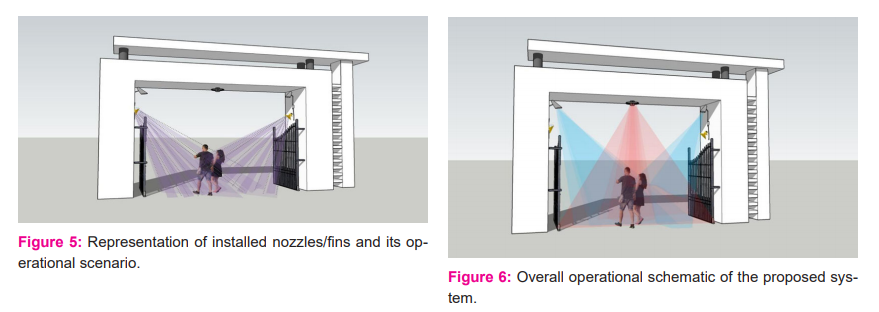IJCRR - 13(4), February, 2021
Pages: 29-32
Date of Publication: 16-Feb-2021
Print Article
Download XML Download PDF
A Novel Method of Mass Disinfection for the Prevention of Covid-19
Author: Nikhil Raj, Ankit Dasgotra, Vishal Kumar Singh, Surajit Mondal, Abhishek Sharma, Jitendra K Pandey
Category: Healthcare
Abstract:Introduction: The lockdown amid COVID-19 across various countries, the sealed borders and immobilize public is a danger to the economy. Objective: In the static scenario of the economy, it is of utmost priority to get the economy moving. Methods: To mitigate the spread of coronavirus disinfection is a technology solution by using a secondary form of Ultraviolet \?C (UVC) light exposure along with disinfectant spray. Results: The taken consideration is not harming the human being and may be an effective way to prevent the further spread of the COVID-19. Conclusion: In this paper we aim to represent that using UVC along with disinfectant spray is one of the effective solution for humans.This paper represents the way to do the same by using a secondary form of Ultra Violet - C (UVC) light exposure along with disinfectant spray measures.
Keywords: Prevention, Smart technology, UVC Light, Disinfecting technique, COVID-19
Full Text:
Introduction
With the origin of coronavirus disease (COVID- 19) in China in December 2019 and after observing the rate of the impact, the WHO declared this disease as pandemic on March 11, 2020. Since then this disease has spread globally with spontaneous transmission rate and infected more than 24.36 million confirmed cases and over 0.83 million fatalities all over the globe.1,2 In Inda the lockdown was implemented by the government on March 23 with little over 100 cases. Since then the lockdown had continued for 3 months and then the reopening was done in phases but the cases have gradually increased. The spread of the disease has the emerging cases of coronavirus in India are depicted in figure 1 which and the numbers are still growing even after the mitigation measures taken by the government to prevent the spread. The major impact has been seen in Lifestyles of people and eduction patterns has been impacted the most.3 Due to this, people got more concerned about safety.
The ultraviolet (UV) radiation are well known for its inactivation approach on various types of microorganisms, virus and UVC whose wavelength ranged from 200-280 nm can be used in several medical applications and due to its highly effective antimicrobial and antiviral properties it is being used in the decontamination process.4,5 A low-pressure mercury vapour arc lamp is used with a conventional UV lamp to emit wavelength within the range of UVC.6 The UVC radiation does not generate any human health risks in comparison to the conventional UV light.7
COVID-19 is a pandemic situation nowadays so many researchers are focusing on this emerging topic and contributing their part in their respective field. Interdisciplinary research is highly encouraged in this emerging situation resulting in the proposal of new concepts, theories and methods towards the construction of healthy cities. In this article, we are proposing an advanced preventive method for mass disinfection using UVC scattering with disinfectant. This methodology can be applied as an infection controlling techniques inbuilt and transportation environments, such as offices, hospitals, shopping malls, airline cabins, trains, buses, cruise ships etc.
The paper is structured in four segments. The first segment describes the technological background of innovation. The second segment describes the actual methodology for the operation of the proposed system and its characteristics. The last segment describes the conclusion of the proposed methodology.
Methods of Prevention
The exponential increase in the number of COVID-19 cases can be only controlled employing prevention, as there is no direct treatment available to cure the disease. There is a various advisory issued by the government to prevent the spread of the virus. The entire economy of the country is paused. As per the economists, a lethal impact and recession is on its way to hit us and may result in more deadly impacts in coming future. To reduce the impact of the same the mass need to mobilize while protecting and preserving themselves from the COVID-19. This is possible if we start integrating the technological advancements in daily life instead of immobilizing the nation and make them still. One of the key technology resources may be UV radiation.
UV rays are considered an effective disinfectant. For dis-infection UV light of short wavelength is used.8,9 The wavelength ranges between 200 and 280 nanometres.10 The process of disinfection is accomplished by ultraviolet germicidal irradiation.11,12 Which either inactivate or destroys the microorganism by attacking the base level, i.e. either deoxyribonucleic acid (DNA) or ribonucleic acid (RNA).13 The base-level attack acts disabling the microorganism to perform any further evolution by high-frequency UV light.
Although the UV rays are not safe for direct exposure to the human, body but then also can be utilized in its secondary form for large mass UV bathing. UV rays may be exposed to the large gathering in secondary form. Mercury vapour lamps can be an alternative to safe exposure of UV rays to the human body.14 It is a two-bulb assembly, where the inner bulb generates the UV light and outer bulb filters the same to make it usable for human needs in daily life. It produces UVC radiation, whose absorption length is so small that it does not penetrate the inner layer of human skin, rather kills the microorganism and dead cells on the skin surface.15 The graph of figure 2 shows the penetration length with increasing wavelength. As the wavelength decreases the scattering increases, which results in reduced penetration.
System Working Methodology
Sensor networking plays an important role in processing as the presence of individual or obstruction has to be detected via scattering range. Figure 3 represents the sensor arrangement with its scattering range that detects the human presence at its entry-level. Passive Infrared (PIR) sensor shall be used to detect human motion. Sensor range can be scattered in a circular pyramid shape, covering major pass by gate area.
Two mercury-vapour or gas discharge lamps are installed as shown in figure 4. These lamps produce ultraviolet C radiation having a wavelength of 253 nm, flashed for a duration of 3.4 milliseconds. The UVC shutter shall be operated at a speed of 1/290 s. The wavelength and flash timing is so selected that it does not penetrate the human skin. The angular positioning of lamps is proposed as it maximizes the area covered.
Disinfecting sprayers turns on automatically after lamp operation. Specific pressure shall be operated in installed nozzles. That further reduces the possibility of any left out the virus and thus transmission chances may be reduced largely. Figure 5 shows nozzle spraying operation and its installation. It also covers maximum range same as mercury-vapour lamps. The preferable disinfecting solution can be ethanol having a maximum alcohol content of 70% and pressure is set in a range of 4-8 bar. The single spray will consume approximately 12 ml of disinfectant collectively.
In case, crowd entrance took place in form of human or obstacles (i.e. vehicles, etc.) then there is the possibility that networking can have the irregular operation but our proposed work can work effetely in these conditions too as shown in figure 6.
Conclusion
The proposed method of disinfection is applied to all the places where the people need to enter in mass and exist in mass, for example, shopping malls, factories, schools, and colleges etc. The arrangement can be done at the entrance of large institutions and factories to give a UVC treated bath and kill the microorganism of the mass simultaneously. The steps can prevent the further spread of coronavirus on the mass level. The system can make the economy going by operating the industries and other institution by reducing the spread of the virus. The methodology is designed keeping in mind the dense crowd of Indian economy but is not limited to any region. The same can be applied universally.
Acknowledgements
Authors acknowledge the immense help received from the scholars whose articles are cited and included in references to this manuscript. The authors are also grateful to authors/editors/publishers of all those articles, journals and books from where the literature for this article has been reviewed and discussed.
Conflict of Interest: Nil
Source of Funding: Nil


References:
1. Coronavirus Disease (COVID-19) Situation Reports. World Health Organization. https://www.who.int/emergencies/diseases/novel-coronavirus-2019/situation-reports. Published in 2020. Accessed December 1, 2020.
2. COVID-19 pandemic in India. https://en.wikipedia.org/wiki/Template:COVID 19_pandemic_data/India_medical_cases_chart. Published 2020.
3. Mukhtar M, Mukhtar S. Impact of Coronavirus Outbreak on Changing Educational Patterns of Student and Teachers at Onaizah and Buraydah Private Colleges in Saudi Arabia - A Cross-Sectional Study. Int J Curr Res Rev 2020;12(22):41-47.
4. Erkan M, Wang CY, Krizek DT. UV-C irradiation reduces microbial populations and deterioration in Cucurbita pepo fruit tissue. Environ Exp Bot 2001;45(1):1-9.
5. Kowalski W, Kowalski W. Introduction. In: Ultraviolet Germicidal Irradiation Handbook. Springer Berlin Heidelberg 2009:1-16.
6. Naunovic Z, Lim S, Blatchley ER. Investigation of microbial inactivation efficiency of a UV disinfection system employing an excimer lamp. Water Res 2008;42(19):4838-4846.
7. Ponnaiya B, Buonanno M, Welch D, Shuryak I, Randers-Pehrson G, Brenner DJ. Far-UVC light prevents MRSA infection of superficial wounds in vivo. PLoS One 2018;13(2):e0192053.
8. Downes A, Blunt TP. Proceedings of the Royal Society of London. In: Proceedings of the Royal Society of London 1878:28 (190-195).
9. Wengraitis S, McCubbin P, Wade MM, Pulsed UV-C Disinfection of Escherichia coli With Light-Emitting Diodes, Emitted at Various Repetition Rates and Duty Cycles. Photochem Photobiol 2013;89(1):127-131.
10. Everything We’ve Written About Preparing for the Coronavirus Outbreak. https://nymag.com/strategist/article/how-to-prepare-for-coronavirus-outbreak.html. Published in 2020.
11. Memarzadeh F, Olmsted RN, Bartley JM. Applications of ultraviolet germicidal irradiation disinfection in health care facilities: Effective adjunct, but not stand-alone technology. Am J Infect Control 2010;38(5 SUPPL.): S13-S24.
12. Ascione F, De Masi RF, Mastellone M, Vanoli GP. The design of safe classrooms of educational buildings for facing contagions and transmission of diseases: A novel approach combining audits, calibrated energy models, building performance (BPS) and computational fluid dynamic (CFD) simulations. Energy Build 2021;230:110533.
13. Cheng N, Moe P. Inactivation of Enveloped Viruses ( Coronavirus, H5N1 Virus ) and Disinfection of the Air with Legionella-X 100 Via Ultraviolet Germicidal Irradiation (UVGI ). 2020.
14. Mercury Vapor Lamps (Mercury Vapor Light Bulbs) | FDA. https://www.fda.gov/radiation-emitting-products/home-business-and-entertainment-products/mercury-vapor-lamps-mercury-vapor-light-bulbs. Accessed July 3, 2020.
15. Is UVC Safe? UV Light and Health Effects - Klaran. https://www.klaran.com/is-uvc-safe. Accessed July 3, 2020.
|






 This work is licensed under a Creative Commons Attribution-NonCommercial 4.0 International License
This work is licensed under a Creative Commons Attribution-NonCommercial 4.0 International License